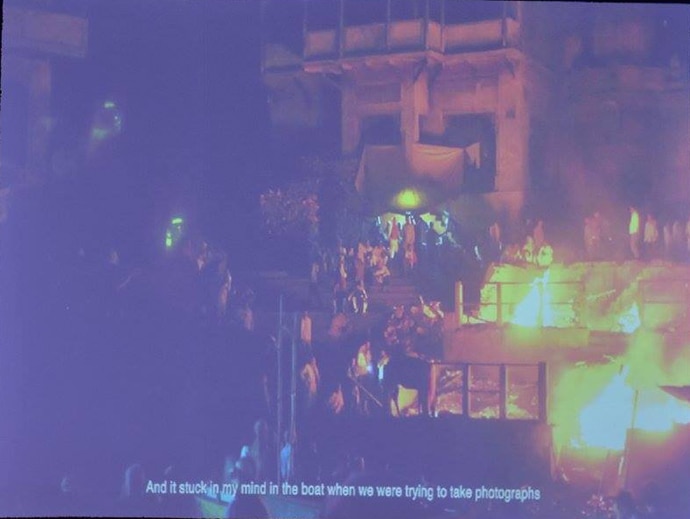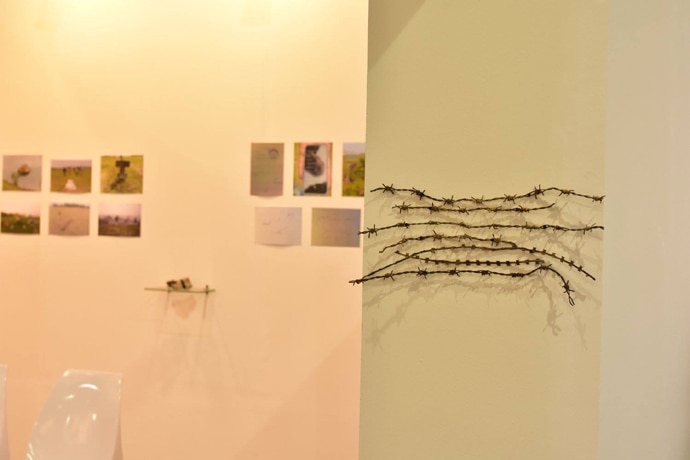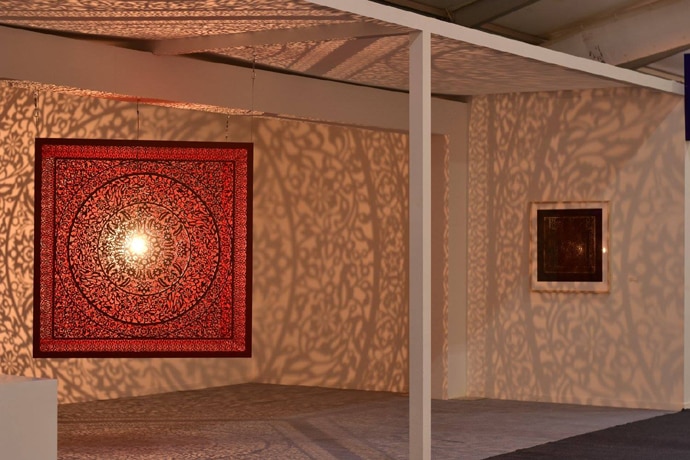It's truly South Asia at India Art Fair 2017

Every edifice was a house of memories of those that were not there anymore. They built the new cities brick by brick, leaving their memories in cement as they moved on and out of these places.
In Dubai, artist duo Thukral and Tagra watched migrant labourers from India build these structures over months and that’s how the idea for Memoir Bar, an interactive project at the India Art Fair’s 2017 edition, found life.
As the art scene pushes its way into the collaborative space, the artists say this particular one is a public project where people themselves collaborate by writing their memories down on a piece of paper and then marking two of six colours based on emotion.
 |
| At the Memoir Bar. Photo courtesy: India Art Fair |
The paper is then shredded and made into a tile with their names and put on a wall.
“It is like a memory bank. Memory becomes an object. It is like solidifying the memory,” they say.
That’s one of the art projects at the art fair that Delhi is hosting from February 2 through February 5. It has expanded to include galleries and artists from the South Asian region. It has found a new investor in the form of Swiss-based MCH Group, which is the owner of the powerful Art Basel franchise.
Founding director Neha Kirpal says the move signals the quest for fresh content in art and pitches the South Asian region as a strong player in the field of arts.
What started off as an art summit has a key role in terms of providing a platform to artists from the region.
 |
| A Tale of Two Cities. Photo courtesy: India Art Fair |
The Kochi-Muziris Biennale that kicked off last month has already been hailed as one of the most interestingly curated biennales where much impetus was given to collaborative works where art forms merged.
Curated by artist Sudarshan Shetty, the biennale's first artist was to be Chilean poet Raul Zurita whose "Sea of Pain" was an ode to the Syrian refugees.
Zurita flooded seawater into an old warehouse at Aspinwall House and, at the end of the manmade sea, there was a poem written in the memory of Galip Kurdi, the brother of the drowned Syrian child refugee Aylan Kurdi.
“We have a lot of collaborative projects like the Tale of Two cities, a travelling project based in two countries - India and Sri Lanka - where artists are engaged in a research-based art-making process,” she says.
She travelled on a sacred route portraying the emotional journey of pilgrims. The mapped landscape wasn’t a physical space but a parallel one of sacred routes, says artist Anoli Perara, describing her responses to Varanasi and Anuradhapura, both sacred sites of pilgrimage.
 |
| 'No Man's Land' by Britto Arts Trust Photo courtesy: India Art Fair |
About her visit to Varanasi, the Sri Lankan artist says she was confronted with the landscape that played out the spiritual and the secular side by side.
In her imagination, the ancient city had always existed within the realms of Buddhist history and was a name associated with Buddha’s first sermon to his disciples.
But then as the 11 artists, who are part of this collaborative project, walked through the city, their responses were different.
Perara’s work was about the maps of pilgrimage that aren’t physical entities but emotional landscapes.
“In a way the two cities became the point of departure for us to discuss larger socio-political and cultural landscapes of both countries,” Perara says.
A Tale of Two Cities was conceptualised by Renu Modi, founder of Gallery Espace, and supported by the Serendipity Arts Trust, and Theertha Artists Collective, which includes multiple works by each artist in the exhibition.
It is a mixture of mediums including painting, installation art, film, sculpture, textile, photography and digital art.
"Varanasi (India) and Anuradhapura (Sri Lanka) from the site, the stage, the place of artistic interpretation and intervention in this cross cultural artistic exchange... These are cities of ritual: sacred and secular, intrinsically interwoven into the life of the people that populate these complex geographies. They are sites of heritage, of myth, of history and memory that have acquired many meanings. Located in states of transit - much like the two cities that sit between the terrains of history and religion, sacredness and modernity, life and death, war and peace, violence and healing - the travelling artist becomes provocateur, sifting through versions of truths, signifying frames and the many ideological claims on the two cities,” the catalogue reads.
 |
| All The Flowers Are For Me' by artist Anila Quayyum Agha. Photo courtesy: India Art Fair |
Ruhanie Perera, a performer, performance-maker and lecturer working in Colombo says she was trying to build a conversation around sacred sites born out of a reflective process.
“We were there in the present but also in the past. It was all about how we created little pockets of storytelling and each art work is a result of a long period of thinking and the pieces are conversations,” she says.
The artists were taken to both the cities and asked to make art that resonated with their responses to the cities.
"In the different stages of my process, the visuals of the throne, crown and sword occurred to me - referencing the history of "protecting" Buddhism as a history of violence and war. They became a reminder of the power dynamics that frame the spiritual unknown," says Pala Pothupitye, another artist.
 |
| Untitled, a steel, textiles and light bulbs work by Chittrovanu Mazumdar. Photo courtesy: India Art Fair |
Renu Modi, founder of gallery espace, Theertha Artists Collective and with programming by the Serendipity Arts Trust, says she first toyed with the idea in 2001 when she had done a similar project in Hardwar where she had asked artists to make works based on their responses to that city.
"Times changed, things changed and I wanted to cross boundaries. I have a fascination for the Ganges and it has been this affinity for the Ganges that made me do this project," she says. She remembers a particular boat ride in Varanasi with the artists in 2015 where she noted the responses of the artists to the city.
"Someone talked about the end of life, another spoke about the pilgrims," she says.
"A Tale of Two Cities is not just an art exhibition, it's about artists coming together and starting a conversation in response to their own country, and one another's. Between India and Sri Lanka there are a lot of similar and often interconnected cultural, religious and political issues. Each of the artists involved in this project have a distinct voice and aesthetic. They are each established in their own practice and known internationally. This project started as a series of conversations at Gallery Espace, and with the Theertha Artists Collective in Sri Lanka. The support of Serendipity Arts Trust was integral and has made it possible for us to build the archive material and take the travelling exhibition to venues across India and Sri Lanka."
Among the other artists, there is Chittrovanu Mazumdar, an artist of the darkness, whose River of Ideas, a large installation at the ongoing Kochi Muziris Biennale, was a windowless, black-painted hall that contained Mazumdar's work - electric blubs, hundreds of which are bunched together into amorphous shapes - to emphasise that darkness is not a negative space, but a context to light.
Mazumdar will be showing at the art fair after a gap of four years.
"This is a kind of progression from Kochi," he says about his project. "There are heavy metal boxes, which are kind of little narratives and the emphasis is on the ephemeral, on the passing moments. It is all in the moment, he says.
"We need darkness. If there would be no darkness, there would be no shadow. Without space in between words, without the silence, there would no note, no meaning. Darkness and light work together in tandem."
The artist, who lives in Paris and India, conceives his art in a small village in Jharkhand where he lives in a remote place and where light assumes a different meaning given the place had no electricity for many years and that's how he saw the starry nights and the hurricane-candle lit evenings and darkness became the incubator for his work.
"The India art fair gives us a platform. We have a fantastic history of visual arts and I think it is only fair that we can show the work. It is a beautiful time to be there. It is a great moment," he says.

